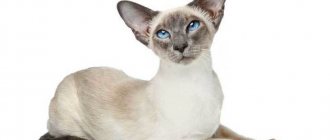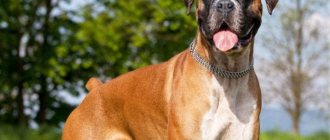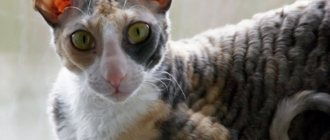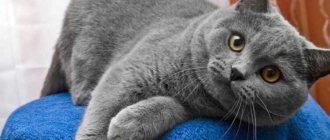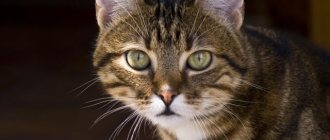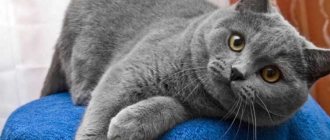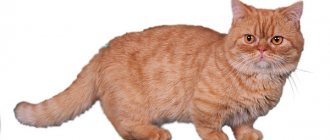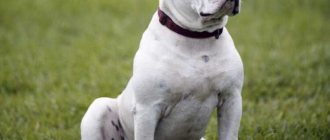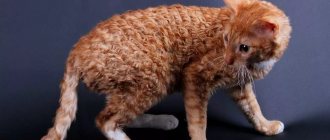The breed of short-tailed cats is gaining increasing popularity among breeders. The secret of their charm is the combination of strength and softness in both appearance and character. In appearance, a bobtail cat is similar to a lynx, faithful, like a dog, affectionate and gentle, as befits a cat. The bobtail's coat can be short or long, but its main distinguishing feature is its short tail.
Bobtails are cats with short tails.
History of the origin of bobtails
The name of the breed “Bobtail” translated from English means “short tail”. Bobtails are cats that have a short tail or no tail at all. This feature is caused by a genetic mutation and is fixed in the phenotype of bobtail cats.
Bobtail cats are excellent hunters, with strong hind legs and an amazing sense of balance, despite the lack of a tail. The original appearance and goodwill of the character have made tailless cats desirable in many homes around the world.
All bobtails are of natural origin
There are many versions about how such cats were born. There is a myth about the appearance of tailless cats during the Great Flood. According to this version, Noah, while letting in a late cat, was in a hurry and accidentally cut off its tail with the door.
Another option suggests that cats with short tails appeared in Japan before our era. The imperial family loved bobtails so much that the cats were given the privileges of the ruling classes and were revered just like the royal family. One of the great emperors decreed that only he could have and breed such a beautiful cat. When he gave audiences in the Imperial Garden, he always took his bobtails with him on red silk leashes.
Geneticists explain the origin of cats with short tails as a mutation. Mother cats chewed off their kittens' regular tails, since the cubs did not fit in the cramped den. It was by this tail that the predator could pull the kitten out of the hole. And subsequently a natural mutation occurred, as a result of which short-tailed cats appeared.
The latest version is related to genetic characteristics. By a strange coincidence, all tailless cats originate either on islands or in states with a closed way of life. The cats did not leave their territory and lived in isolation for a long time. Under such conditions, inbreeding becomes possible, which may be the cause of a genetic anomaly.
Breed traits
Breed traits (on a 5-point scale)
| Bobtail (Old English Sheepdog) | |||
| Activity | in the house | 2.7 | |
| on the street | 4.3 | ||
| Obedience | training | 3 | |
| strangers | 4 | ||
| Domination | in family | 3.3 | |
| over dogs | 2.3 | ||
| Defending your territory | from people | 3 | |
| from dogs | 2.7 | ||
| Sociability | in family | 4.7 | |
| with strangers | 3 | ||
| with dogs | 3 | ||
| Concentration | in family | 1.3 | |
| in front of strangers | 2 | ||
| with dogs | 2.7 | ||
| Aggressiveness | in family | 2 | |
| to strangers | 2.3 | ||
| to the dogs | 2 | ||
| to cats | 1.7 | ||
| Family behavior | calmness | 3.3 | |
| demand for affection | 3.3 | ||
| excitability | 3.7 | ||
| playfulness | 4 | ||
| excessive barking | 2 | ||
| behavioral breakdowns | 1.7 | ||
| Tolerance for children | up to 4 years | 3 | |
| over 4 years old | 3.3 | ||
| Institutional use | watchman | 3.7 | |
| bodyguard | 3.7 | ||
This breed is often compared to the following dog breeds: Bearded Collie, Briard, Belgian Shepherd Tervuren, Rottweiler, German Shepherd.
The photo shows what a bobtail looks like:
Bobtail - external features
All subspecies of the bobtail cat breed have common features. Regular cats have 20-23 vertebrae in their tail, short-tailed bobtails have from 2 to 15 vertebrae. Typically, an animal's tail is a balancing tool that helps them flip over when jumping or falling to land on their feet. In bobtail cats, this function is performed by muscles. They have a strong build, powerful paws and a wide chest.
The color of bobtails depends on the variety; the color of the coat can look different and have different shades, as well as stripes, spots, and smooth transitions of halftones.
All types of bobtails have common features
Training and education
When training a bobtail, you need to be persistent and patient. Puppies are very energetic and naughty, but are willing to serve humans. Under no circumstances should you raise your voice or punish them too much; they take this very painfully.
Teaching a bobtail puppy commands is a very important part of the training process. Through training, the principles of discipline and self-control are instilled in the animal. A well-mannered dog will become safety and pride for every owner. Also, a disciplined pet will help out in case of potential problems during walks; it will not scare passers-by, chew slippers, create a mess in the house in the absence of its owners, etc.
Why train a bobtail?
- Firstly, when the dog learns commands, it will become more disciplined. After all, the animal must clearly understand what is allowed and what is strictly prohibited. If a dog lives in a family with children, everyone should feel comfortable being around it.
- Secondly, the dog must understand its place near the person. Pets come from wolves, where there is always an alpha in the pack, so the owner must become the leader. It is necessary to form an obedient, but at the same time respectful attitude towards the person.
- Thirdly, a dog often performs some function: watchman, hunter, guide, companion. Therefore, the animal must be trained in special commands in order to be able to perform a particular role. In such cases, the dog should be trained by a professional dog handler. Quite often, a dog is adopted as a friend with whom you can have fun. The animal becomes strongly attached to the person, and a strong friendship bond arises.
A bobtail puppy has appeared in the family, then help him get used to it faster and survive stress. To do this, it is enough to feed him with your own hands, play with him, communicate and spend time. Such simple actions will help establish a trusting relationship. The more the owner pays attention and care, the more loyal the dog will grow.
Variety of bobtails
There are several subspecies of cats belonging to the bobtail breed. Let's list the main features of different bobtail cats and make characteristics of the breeds:
| Japanese | Kuril | Karelian | American | Mekong | |
| Head | The shape is an equilateral triangle, but in appearance it appears long and elongated. The nose is long and wide. High cheekbones. | Large, trapezoidal in shape, with smooth contours. The muzzle is wide. | It has the shape of an isosceles triangle. The profile is almost straight. The forehead and cheeks are flat. The muzzle and chin are narrow. | Wedge-shaped, with rounded contours. Proportional to the body. The muzzle is wide. Clearly prominent cheeks and mustache pads. The nose is wide, with a small hump on the bridge of the nose. | Round shape. Almost flat on top. The muzzle is oval. The nose is “Roman” (wide with a hump). |
| Ears | Large, widely set. Pointed upward. | Medium in size. Wide. Quite widely set. The ends are rounded. | Large, high set, vertical. | Medium or slightly larger in size with slightly rounded ends. Tassels on the ears are a desirable element. | Large, wide at the base. The tips are slightly rounded. Set high and laid back slightly. |
| Eyes | Large, oval. In profile you can see that they have a pronounced slope. The eyes are in harmony with the color, although blue-eyed individuals and even those with different eye colors are acceptable. | Round, widely set. The color is in harmony with the color. | Oval shaped, close set. The color matches the color. | Large, almond-shaped. Color may not correspond to color, with the exception of mink, sepia and colorpoint colors. | Large, oval, bright blue. |
| Body | Medium size. Graceful, long. The muscles are developed. | Compact, muscular, with a slightly arched back and raised croup. | Medium size, not stocky or elongated. | Medium size. Muscular. The chest is wide. | Medium, muscular, but at the same time graceful. |
| Legs and paws | Long, slender, strong. The hind ones are much longer than the front ones, which is visible to the naked eye. Oval shaped paws. | Strong. The hind legs are longer than the front ones, the legs are rounded. | Medium length and strong, hind legs slightly longer. The paws are round in shape. | Proportional to the body, strong. In long-haired individuals, tufts of hair between the toes are welcome. The paws are large and round in shape. | Average, slim. Oval shaped paws. |
| Tail | Not longer than 7 cm, but clearly visible. May consist of one or more bends and corners. | From 3 to 8 cm excluding wool. It must have creases and bends, one or more knots in various combinations. | From 4 to 13 cm. With kinks or curved. | From 2.5 to 8 cm. | Must have at least 3 vertebrae. Hooks and knots on the tail can be in any combination. |
| Wool | Can be of any length: short, extended and long. The undercoat is weakly expressed. The hair on the front part of the body may be shorter than on the back. It is desirable to have tufts in the ears and legs. | Middle length. The undercoat is weakly expressed. It is desirable to have a “collar”, “jabot”, “pants”, ear brushes and tassels. | Short or medium length. | There are short-haired and long-haired. In both cases, the coat is very thick, the undercoat is moderately developed. In individuals with long hair, increased shaggyness is observed on the chest, paws, belly and tail. | Short, silky. The undercoat is weakly expressed. |
| Color | All colors are acceptable, except chocolate, lilac, colorpoint, ticked tabby. The most common colors are bicolor and tricolor. | All colors are recognized except chocolate, lilac, cinnamon, fawn (including tabby, bicolor, tricolor), and colorpoint. | All colors are recognized except chocolate, lilac, cinnamon, fawn (including tabby, bicolor, tricolor), and colorpoint. | May vary. The most preferred coat color is tabby. | Colorpoint of any point color without white. The paws, tail and muzzle are darker in color. |
| Weight | 2.5-5 kg | 3-6 kg | 2.5-6 kg | 3-8 kg | 2.5-6 kg. |
| Height at withers | Up to 32 cm | Up to 30 cm | Up to 28 cm | Up to 30 cm | Up to 30 cm |
| Price | From 200 to 500$ | From 70 to 500$ | Up to $1000 | From 500 to 1300$ | From 70 to 200$ |
| A country | Japan | Russia | Russia | USA | Thailand |
Japanese Bobtail
The history of the appearance of Japanese bobtails dates back to approximately the 16th century. There is a version that these cats arrived in Japan from India, while bypassing the territory of China. Representatives of this breed can be seen in ancient paintings and engravings of the imperial palace, and their descriptions are also found in legends and myths.
Since ancient times, Japanese bobtails have lived in Buddhist temples and in the chambers of the Emperor of Japan.
Tailless cats were highly respected and loved in Japan. The ancient Japanese believed that cats with long tails brought bad luck and could turn into werewolves. Therefore, they cut off part of the tail, leaving only a “bunny tail”. There is speculation that centuries of tail trimming led to a mutation that caused the development of the unusual Japanese bobtail.
The breed received its modern development after World War II, when it was brought to the United States. Japanese bobtails received official recognition in 1976.
In ancient Japanese paintings you can often see tailless cats.
Japanese Bobtails have a balanced temperament; the cats are friendly but independent. The Japanese have a developed intellect and get along easily with children.
Kurilian Bobtail
The history of the Kuril (sometimes you can hear Kamchatka) bobtail can be traced back to the 19th century. The ancestors of the bobtail lived on the Kuril Islands, the Kamchatka Peninsula and Sakhalin Island. According to one version, these cats directly descended from an ancient domestic breed - Japanese bobtails. Having arrived in the Kuril Islands several centuries ago, they became wild again and acquired new hereditary characteristics. According to another version, Kurils originated as a result of natural crossing of Japanese bobtails with Siberian cats brought to the Kuril Islands by settlers.
In the twentieth century, unusual cats began to attract the attention of geologists and military personnel arriving on the Kuril Islands; they often tamed them and took them with them to the mainland. For a long time these cats were not distinguished from Japanese bobtails, which is why the development of the breed began only in 1980. In 1995, the Kurilian Bobtail was officially recognized by the international federation WCF.
The Kuril Bobtail lived for many years on the Kuril Islands and was unknown to the world
The Kurilian Bobtail is a very loyal pet. He chooses his owner himself and considers him to be the leader of the pack. They remember commands very well, but carry them out of their own free will. Kurilians love to walk in the fresh air, and like American Bobtails, they love outdoor games. In addition, smokers have virtually no smell.
The Kurilian Bobtail is a big fan of hunting. He will catch all the rats and mice in the area, and then he will deal with insects and even fish. Far Eastern cats are not afraid to dive, since the specific structure of their ears allows them to be folded in a special way, preventing water from getting inside.
Kurilian Bobtail cats are smart, highly trainable and courageous. They can easily replace a dog in terms of devotion to the owner and sociability.
Karelian Bobtail
The Karelian Bobtail is considered a descendant of the Norwegian wild cat. It was discovered in Karelia in the 90s of the twentieth century. The breed arose spontaneously and was preserved thanks to the beliefs of local residents, according to which this cat brings happiness and good luck.
The breed was first shown at an exhibition in 1987. And three years later, cats were officially recognized. Despite all the efforts of breeders and external beauty, Karelian bobtails are considered very rare. Few breeders undertake their breeding.
Karelian Bobtails are very beautiful cats
Karelian Bobtails have a friendly and affectionate disposition, they are unobtrusive and have a good sense of people’s moods. They adapt well to any living conditions and do not experience stress when moving or traveling.
American Bobtail
In the genes of the American Bobtail you can find Siamese cats, Redgalls, Manx cats and simply outbred short-tailed cats. A standard was developed in 1970, and the American Bobtail received worldwide recognition in 1989.
The American Bobtail has a diverse combination of breeds in its genes
The American Bobtail is a robust cat with a characteristic naturally short tail. The tail must be present; its absence indicates the presence of a disease of the spine and joints. Thanks to his athletic build and specific facial features, the American gives the impression of a wild animal.
American Bobtails are very calm, patient and have an easygoing and gentle character. They love their owners and do not tolerate loneliness well. Americans are patient with other animals, including dogs.
American Shorttails have a gentle and friendly character.
In the USA, American Bobtails are widely used in therapy because they are very sensitive to human moods.
American cats love outdoor games, are easy to train, love communication and walks in nature. Because the American Bobtail breed is young and still developing, personality traits may change in future generations.
Mekong or Thai Bobtail
The Mekong or Thai Bobtail is an ancient cat breed in Thailand. According to legend, this cat lived in aristocratic families, and its short tail was used for stringing and storing jewelry. Presumably this breed appeared as a result of mutations of Siamese cats.
Once upon a time, the Mekong Bobtail was prohibited from being exported outside the borders of Thailand. Fortunately, at the beginning of the twentieth century, several Mekong kittens were presented to the English ambassador.
Later, felinologists worked on the breed, and with the beginning of the 21st century, the Mekong Bobtail standard was established. Currently, this is a rather rare breed, but the fashion for it is gaining momentum.
Rich Thai aristocrats hung their jewelry on the tails of Mekong bobtails.
Mekong Bobtails resemble dogs in some tastes and habits. For example, they calmly walk on a leash, love to play, bring things to their owner in their teeth, and when he leaves, they guard his things and do not allow strangers to take them. Mekongs are very patient with children and get along well with other pets.
Types of bobtail cats
The types of bobtails that are known today began naturally at different times. The photo shows the main varieties of bobtail cats:
American, bred by felinologists in the early 80s. It took two decades to create this variety. Features include striped color, large size, and “knots” of the tail.
Karelian, thick coat with undercoat, close-set eyes, varied color except spots. A successful hunter, a loyal friend, behavior close to that of a dog.
The Kamchatka bobtail cat may have evolved from the Japanese bobtail. Luxurious fur, round eyes.
Mekong, bred in Thailand. Features: small size, characteristic “Siamese” color, slanting blue eyes. Capable of protecting the house like watchdogs.
Manx, a British variety of almost tailless cat, is large, weighing up to 7 kg. The coat is thick and striped in color. The eyes are large and round, creating a surprised look.
The pixie bob, a smaller version of the natural lynx, has a short tail and up to 7 toes on the hind feet, common in Canada and the United States.
Japanese, known since the 16th century, the breed was recognized in 1993. Small specimens weigh up to 4 kg, with a curved tail. The color is white, with black or red spots. The eyes are slanted, wide open, often of different colors.
Character and habits
The main feature of bobtails is friendliness. Cats get along well with other pets in the house and with small children. They are characterized by a love of outdoor games with their owner and family members. Because of their love and devotion to humans, bobtails are often called dogs in cat form.
Japanese bobtails even know how to give a paw as a greeting. There are numerous statues of cats in this pose in Japanese temples.
Many short-tailed animals consider it their duty to protect the house. If they sense a danger to themselves or their owners, their friendliness can end instantly. All bobtail cats have developed intelligence, so communicating with them is a pleasure.
Bobtails are very sociable animals.
What to feed and pamper
For short-tailed cats, natural or high-quality dry food is preferable. A large amount of hard and hard food is desirable in the diet: bones, chicken stomachs and cartilage.
Feeding a cat raw, clean meat is dangerous; it is better to combine fresh chicken, fish with dry food. Your pet's bowl should always be filled with unboiled water.
Brave and courageous bobtails will become a devoted friend for a person and even an excellent nanny for small children.
Siberian cat - history of the breed, description, character and habits + 95 photosOriental cat - history of the breed, modern standards, character, care, nutrition + 83 photos
- Maine Coon - history of occurrence, description of the breed, character + 84 photos
With their boundless affection, they are more like a purring dog: they are also faithful, do not leave their home without their owner and follow on his heels everywhere.
Diseases
Bobtail cats are in good health and have not been diagnosed with any genetic diseases. However, some bobtail breeders note that the absence of a tail can cause inflammation of the anus and rectal prolapse. Therefore, it is important to examine your cat from time to time to identify redness or cracking in the anus in advance. Otherwise, all bobtails need the usual procedures for all cats - preventive vaccination and treatment for parasites.
The life expectancy of bobtail cats is quite high. With proper care, they live for more than 15 years.
Mekong Bobtails are the longest-living breed not only among bobtails, but also among cats in general. Their lifespan is 20-25 years.
Mekong cats are the longest-livers of the cat world.
Bobtail cat health
Bobtails have a lifespan of 13–15 years and are a relatively healthy breed due to their natural development. Cases of being born without a tail can lead to problems with the spine.
Due to the unequal length of the front and rear legs, hip dysplasia, an inherited disease that can cause lameness and arthritis of the hip joints, develops with age.
Tailless bobtails may develop a spinal disorder in old age that will affect their ability to control bowel movements.
Breeders screen kittens for health problems, but it is important that animals are monitored regularly until adulthood. Health problems may go undetected until the very end of a cat's life. Regular examinations by a veterinarian will be the basis for a calm life for the owner and his pet.
Feeding pets
Bobtails are very sensitive to the quality of food, both natural and ready-made. Breeders recommend a natural diet for bobtails with a sufficient amount of meat and sea fish. Let's list the natural products that are required and prohibited on the short-tailed fish menu:
| Can | It is forbidden |
| Raw frozen beef, boiled boneless chicken. Boiled low-fat sea fish. No bones. Chicken or beef by-products - hearts, lungs, liver, kidneys, raw or boiled. Raw or boiled egg yolk, pure or grind with kefir, add to porridge. Fermented milk products: sour cream, kefir, fermented baked milk, yogurt, cream - all medium fat, without sugar or additives. Fresh, non-acidic cottage cheese can be mixed with sour cream or raw egg yolk. Cereals: rice, buckwheat, steamed oat flakes, wheat groats. Boiled cereals are mixed in a 1:2 ratio with boiled meat or boiled fish. Vegetables, raw or boiled: carrots, cauliflower and others. Mix in a 1:2 ratio with boiled meat or boiled fish. Greens, sprouted wheat grains, special grass for cats. | Food from the human table. Salted, fried, smoked food. Pork, lamb, goose, duck. River fish, seafood. By-products – spleen, chicken necks and bones. Egg white. Butter, salted cheese. Citruses, kiwi, pineapple, persimmon. Nuts and beans. Potatoes, onions, garlic, tomatoes, eggplants, mushrooms. Confectionery. Bread and other baked goods. Tea coffee. Alcohol. |
The peculiarity of the intestines does not allow bobtails to consume dairy products and potatoes.
The proportion of proteins, fats and carbohydrates should be as follows - 60-70% protein, 10% fat, 20-30% carbohydrates. It is best to check with your veterinarian for serving size.
Ready-made foods are also suitable for bobtails, but they should be premium foods, since cheaper ones cannot always sufficiently provide the animal’s body with nutrients. The serving size must correspond to the standards indicated on the packaging.
General characteristics of the breed
A characteristic feature of this dog’s appearance is its short tail, reminiscent of a bob. Therefore, the name of the breed bob-tailed sheep-dog is translated from English as “shepherd with a tail like a bean.” This is a congenital feature, but some puppies are born with a long tail, in such cases it is docked. The Bobtail is also called the Old English Sheepdog, as it appeared in Great Britain in ancient times.
Bobtails are strong, hardy dogs. They are muscular, strong, and capable of hard work. They can carry heavy objects, perform various tricks, and perform in the circus. Bobtails have acting qualities; representatives of the breed have starred in several films.
Nowadays they are rarely used as shepherds; bobtail guards are also poor. Although they have an instinct to protect the territory, they also will not give offense to the owner, but they treat all people kindly, affably, and never show aggression. Thanks to their tolerance, attentiveness and people-oriented approach, they often work as guide dogs for the disabled and therapy dogs for children with developmental delays.
| Options | Characteristic |
| breed name | Bobtail, Old English Sheepdog |
| a country | Great Britain |
| group of breeds according to the ICF classification | herding and cattle dogs, shepherd section |
| application | shepherd, guide dog, therapy dog, sled dog, companion |
| appearance features | large stature, lush wavy coat, short stubby tail |
| life expectancy | 12-13 years old |
| height | males 56-63 cm, females 54-61 cm |
| weight | males 34-46 kg, females 32-44 kg |
| character traits | friendly, calm, devoted |
| activity | average |
| aggression | No |
| intelligence | smart, quick-witted |
| difficulty of care | complex coat care, although sheds infrequently, grooming and trimming are required |
pros
The Old English Sheepdog is popular because of its calm, friendly nature. But it has a few more advantages:
- balanced temperament;
- chic appearance;
- friendly, not aggressive;
- devoted, faithful, loves to spend time with the owner;
- hardy, efficient;
- smart, has a good memory, easily remembers commands;
- loves children, is patient with them, can be a nanny;
- gets along well with other pets
Minuses
This breed is large, active, and difficult to keep in a city apartment. It should not be owned by inactive owners, or by those who are away from home for a long time. Bobtails do not tolerate loneliness well. They have a few more disadvantages:
- They shed heavily and are not suitable for owners with allergies;
- slobbery, bring home a lot of dirt from the street;
- require long walks with physical activity;
- Grooming is difficult and maintenance is expensive;
- poor health.
The video will complement the characteristics of the breed:
Video: Old English Sheepdog (Bobtail). Breed characteristics, care
Video: Bobtail - interesting facts about the dog
Video: Bobtail is a breed of good-natured and absolutely non-aggressive dogs
Care and maintenance
The hair of bobtail cats is unique - no matter how long it is, it does not tangle or get dirty. The coat of short-tailed cats is combed once a week. It is recommended to teach this procedure from childhood. It is especially important to comb the coat during seasonal shedding. When combing, it is necessary to touch the tail as little as possible, since this is unpleasant for animals.
Bobtails need to be bathed once every two weeks using a special shampoo. Cats of this breed treat water with love rather than hostility. This is especially true for the Kuril Bobtail, which lives in climates with high humidity. The fur of Kurils doesn’t even get particularly wet – the water just rolls off it.
Bobtails have a unique coat
You need to trim your nails at least once a month. Periodically, you need to wipe your eyes to prevent dark discharge from appearing. Bobtails also require regular examination and cleaning of teeth and ears.
You can go for a walk with your bobtail at least every day. Kittens get used to the harness very quickly and do not cause any trouble.
Advantages and disadvantages of bobtails
Advantages of bobtails:
- attractive exterior;
- playfulness;
- lack of aggression;
- balanced character;
- high intelligence;
- no problems with upbringing;
- cleanliness;
- pickiness in food and care.
Flaws:
- tendency towards obesity among “Americans”;
- desire to take a dominant position (Japanese);
- unfriendly attitude towards strangers (Japanese);
- hyper-reactivity;
- early sexual maturity in the Mekong.
Bobtail breeding
Bobtails are prohibited from crossing with cats of other breeds. To breed these cats, you need to adhere to the following recommendations:
- A cat should go through 1-2 heats before mating. In this case, the cat must not be younger than 1 year and its body must be fully formed. The cat must also be at least 1 year old. The optimal age is one and a half years.
- At least one of the partners must already be experienced in this matter;
- Both pets must be healthy and vaccinated 14 days before;
- You should not wash your cat before mating, so as not to deprive her of her natural scent;
- The date should take place on the cat’s territory, the cat is left there for 3-5 days;
- Mating is prescribed on the 2-3rd day of estrus.
In addition, when choosing a partner, you need to pay attention to the length of the tail. If a cat's tail reaches 8-12 cm in length, then a cat's tail should be much shorter. This produces offspring with a tail from 3 to 8 cm.
Bobtail baby
Pregnancy and childbirth usually proceed without any special features. But if the breeder is inexperienced, it is better to play it safe and arrange for the presence of a veterinarian.
Kitten in the house
Kurilian Bobtail kittens are very active and love to run. Therefore, they need a lot of free space. To diversify your favorite pet’s leisure time, you can install a cat simulator at home, consisting of all sorts of labyrinths.
Care and feeding
You need to find out from the breeder what to feed the kitten. It is better to start feeding with milk, gradually adding special food for kittens, but it is advisable to start giving it no earlier than 2 months after birth.
Weight by month
For each age interval, a Kurilian Bobtail kitten must reach a certain weight. The weight should be something like this:
- A cat should weigh 750 g, a cat should weigh 800 g in 45 days;
- 1100–1500 grams - optimal for 2 months;
- at 6 months the weight of the female should reach 3 kg, and the male - 4 kg;
- the weight of an adult cat is 3.5–5.5 kg, a male cat is 5–7 kg.
How to name a kitten
Ideal nicknames would be short and masculine names. If a person does not know what to name a cat, then an excellent name for cats would be: Billy, Cherry, Bob, Johnny, Teddy, Ollie. Cats can be called: Bonnie, Sally, Jackie, Kitty.
They also respond to names with hissing or dull sounds as part of the word. Or you can choose names based on the color of the animal, for example: Tiger or Lynx.
How to choose a kitten
Bobtail cats are considered rare and exotic. Therefore, it is better to purchase a kitten in nurseries or from breeders with a good reputation. General rules for choosing a kitten for all breeds and bobtails, in particular:
- The kitten should be active and playful, not afraid to approach people;
- Eyes and ears should be clean, the skin should be free of wounds and ulcers;
- The mouth should be clean and pink;
- The tummy should not be bloated;
- The fur under the tail should be clean, there should be no cracks or redness on the anus;
- If it is not possible to see the kitten in person, then you need to request a photo of him and his parents;
- A veterinary passport and pedigree are required;
- The optimal age for changing homes is 3 months.
A short tail is a distinctive feature of a true bobtail. The presence of creases and hooks depends on the breed.
Bobtails are becoming increasingly popular among breeders
Bobtails are not suitable for a person who prefers a calm animal, as they are very active and playful. But in all other respects, this is an ideal pet. He is cheerful, obedient, and does not require special care. The bobtail breed is relatively young, so these cats are not very common. But their popularity is growing year by year and, fortunately, each animal finds a loving owner.
Mr. Cat warns: diseases and vaccinations
Any artificially bred breed has mutations. This statement is also true for bobtails. Despite the fact that selection was carried out not by man, but by nature, the change in the genotype led to its consequences.
Distinguished by their good health, smokers are predisposed to diseases associated with their origin and structure.
It is believed that the structure of the tail has a direct effect on diseases typical of a cat of this breed: hemorrhoids, inflammation of the anus, intestinal prolapse.
A common illness is urolithiasis (UCD). If there are problems with the cat’s kidneys, it is necessary to switch from food for the prevention of urolithiasis to a special one that restores kidney function.
The first vaccination of cats is done at the age of 6-8 weeks. Recommended vaccine against rhinotracheitis (FVP), calicivirus (FCV), paleukopenia (FPV). After 4-6 weeks, an enzyme-linked immunosorbent assay is performed. Based on the results, further vaccination is performed. The rabies vaccination is carried out at the 16th week. Further booster vaccinations are required annually, and screening for parasites (helminths) is also necessary.
Standards
| Standard | Description |
| Eyes | Rough, large and expressive. The iris can be any (snow-white cats have both blue and multi-colored eyes). |
| Head | Large, with smooth, rounded contours, wedge-shaped. The ears are small, with a wide base and rounded tips. They are slightly inclined forward and are equipped with tassels like those of a lynx. The whisker pads are plump and well expressed. The nose is of medium size, wide, level and straight. The chin is clearly defined, massive, with rounded edges. |
| Torso | The body is powerful, long, with developed muscles and strong bones. The hips are raised, the chest is wide. The limbs are not short, but they cannot be called long either. Powerful and strong. Paws are oval, large, spread out. |
| Tail | The tail is a distinctive feature of the Kurilian Bobtail. Outwardly it looks like a soft fluffy pompom. The length can be different: in cats with semi-long hair - 11-13 cm, with short hair - 1.5-8 cm. There is an undercoat, but it is quite small. |
| Wool | The coat can be semi-long or short. Bobtails with short hair have the same length all over their body. Cats with semi-long hair always have a fluffy collar, “pants” on the hind legs, socks and a plume on the tail. |
Felinologists distinguish 4 types of tails:
- Longest: includes 5-7 vertebrae. At first they form a straight line, and then twist into a loop. But such a tail is considered a serious drawback.
- Tail-broom: here there can be even more vertebrae - 8 or even 10. But the tail remains straight.
- Spiral tail: Also 5-10 vertebrae forming a small hook or spiral.
- The last and shortest tail is a stump. Consists of a minimum of 2 and a maximum of 8 vertebrae that are seriously deformed.
Application
In their natural habitat, Kurilian bobtails are excellent hunters.
On the islands, these cats save houses from rodents, finding rat holes and destroying entire families. Therefore, they should not be kept with domestic degu squirrels or lemmings .
The Kuriles, like the Turkish Vans , are not at all afraid of water, are excellent fishers and will always find food for themselves.
When kept at home, these are active and energetic pets, companions and equal members of the family, just like Ragdoll cats .
Kurilian Bobtails will never do anything that they are not allowed to do, understand their owner almost the first time, and are trainable
Keeping an Old English Sheepdog
The Bobtail is a large dog and will be uncomfortable in a small apartment. Due to the long hair, there can also be problems with apartment maintenance. This dog lives quietly on the street, its thick coat protects it from bad weather. It is better to keep a bobtail in a private house with a large plot.
Walking is mandatory, even when kept on the site. You need to walk 2 times a day for at least an hour. It is better to visit dog parks or go out of town, where the dog can run freely and frolic. You can walk without a leash - a bobtail will never run away, as it is very attached to its owner.
Hygiene procedures are the same as for other dogs. You need to keep your eyes and ears clean and clean them periodically. If the claws do not grind down on their own, they are trimmed with a nail clipper. To prevent tartar, you can give your dog chewing bones and cartilage.
Grooming
Caring for the bobtail's lush coat is difficult. The peculiarity is that they do not shed seasonally. The undercoat changes little by little all the time. And the guard hair sheds 3 times up to 2.5 years and becomes more and more rigid.
It is necessary to brush the dog 3-4 times a week; during shedding, this should be done every day. Show dogs also require professional grooming. Pets often get haircuts. A dog with a haircut is easier to care for and keep clean. Usually the hair on the paws, under the tail, on the belly and head is trimmed. In hot weather, you can cut your bobtail shorter.
If the dog is not cut, it is recommended to collect the hair on its head so that it does not fall in the eyes - it interferes with its vision. It is also necessary to trim the hair between the toes, then the dog will bring in less dirt from the street.
After each meal, the dog must be washed, otherwise the hair around the jaws will turn brown. After walks, wash paws and belly. In dirty weather, it is worth taking your dog outside in waterproof overalls.
It is often not recommended to completely bathe a bobtail; the fatty grease is washed off from the skin. Once every 1-2 months is enough. Be sure to use shampoo for long-haired dogs, conditioner, and antistatic agent. After bathing, it is better to dry the coat with a hairdryer to prevent the skin from burning and developing dermatitis.
From the video you can learn how to care for fur:
Video: Grooming techniques for the Old English Bobtail Sheepdog
Video: Bobtail - washing and drying
Video: Grooming an Old English Sheepdog (Bobtail)
Nutrition
The Old English Sheepdog is unpretentious in food. Veterinarians recommend feeding representatives of the breed with natural products. It’s just important to make the right diet. The dog should not be overfed to prevent it from gaining weight. But food must provide the body with all the necessary nutrients.
The diet of an adult dog should consist of the following products:
- lean meat - poultry, beef, rabbit;
- tripe and other offal;
- cartilage;
- sea fish without bones;
- dairy products;
- cereals;
- any vegetables except potatoes and legumes.
Protein foods should make up at least half of the diet. You should not give your dog smoked meats, fatty foods, confectionery, sweets, or baked goods. When feeding naturally, on the recommendation of a veterinarian, you need to add multivitamins to your food.
You can feed your bobtail with dry food. But you need to choose super-premium or holistic options with a high protein content. They should be designed for large breed dogs, preferably with additives for a beautiful coat. Such food is not cheap and you will need a lot of it depending on the weight of your pet.
Health
Bobtails live as long as other large dogs - on average 10-12 years. Even with proper care, they rarely live longer than 13 years. Their health is also not very good; congenital and acquired diseases are common:
- joint dysplasia;
- otitis;
- eye diseases, vision loss;
- dermatitis, eczema;
- bloating;
- epilepsy;
- diabetes;
- hypothyroidism;
- heart failure.
Bobtails are very sensitive to medications, so if they feel unwell, it is better to consult a veterinarian. It is recommended to undergo regular preventive examinations, get all necessary vaccinations on time, give anthelmintic drugs, and treat the fur for parasites.
